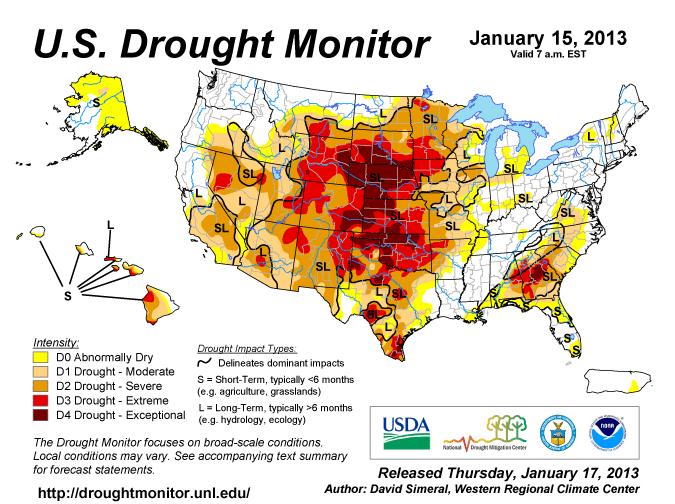The latest map from the U.S. Drought Monitor and predictions from National Weather Service were released today. They show a grim picture of continuing drought for the foreseeable future for large swathes of the U.S.
Approximately 66 percent of the contiguous U.S. is currently in severe, extreme, or exceptional drought. Many of these same areas were in drought six months ago – and even as far back as 2009 in the case of Texas. Below normal precipitation and/or above normal temperatures are expected to persist in some parts of the country that are already drought-stricken, such as the south central and southwestern U.S and the Gulf coast states.
American farmers continue to face challenging conditions
Last week, the U.S. Department of Agriculture released its crop production summary for 2012 which shows the severe impact of last year’s historic drought. Corn production for 2012 was 10.8 billion bushels, 13 percent below the 2011 crop, and yield per acres was 16 percent below 2011 levels – a cruel blow to farmers who had started the growing season expecting a bumper crop. Hay production was at the lowest level since 1964, which had serious consequences for the livestock industry.
The forecast for this year’s spring growing season is not much improved, especially with the already low soil moisture conditions caused by last year’s drought. As the National Weather Service says: Soil moisture is currently very low across the southern plains, and with elevated chances of below median precipitation amounts predicted for the remainder of winter, it appears that dry soil conditions will persist into spring.
Water supplies at risk
Texas has been hit particularly hard by what is now a multi-year severe drought, affecting crops, livestock, and water supplies, and causing significant wildfires. In December 2012, Governor Rick Perry made a disaster proclamation, renewing a similar proclamation he had made in July 2011, and stating that “exceptional drought conditions pose a threat of imminent disaster.”
The Texas Water Development Board’s latest water plan is an urgent call for attention to the fact that Texas does not and will not in the future have enough water to meet its needs in the event of serious droughts like the current one. The long-term implications are substantial. Without significant action, in 2060 water shortages caused by drought could lead to roughly $116 billion in lost income for Texas businesses and workers, lost state and local taxes totaling $9.8 billion, and lost jobs of 1.1 million. It is no wonder then that the issue of water shortages and conservation measures is attracting the full attention of state political leaders.
Record low Mississippi water levels exact economic toll on barge traffic
The drought has also meant record low water levels on the Mississippi river, which is making it difficult for water transportation of critical goods like grain, oil, chemicals, and coal. Delays or closures affecting commercial barge traffic along portions of the river will result in expected losses of about $7 billion through the end of January, according to barging industry officials.
The U.S. Army Corps of Engineers (USACE) is engaged in a massive project to keep navigation channels open, part of which involves excavating the rock bed of the river near Thebes, Ill. The project is expected to cost $10 million.
Grappling with new climate realities
Recent extreme weather events like this extended drought have exacted a heavy economic and human toll on Americans. The risks of some kinds of extreme weather like drought, heat waves, extreme precipitation, and flooding are likely to increase with climate change. This is a reality we all have to grapple with and respond to in a responsible way. Furthermore, as my colleague Alden Meyer blogged today, the Obama administration must show leadership in setting out a comprehensive strategy to lower emissions of carbon dioxide and other heat-trapping gases and increase the resilience of communities and ecosystems to the mounting impacts of climate change.

